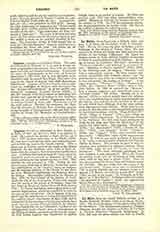

Lagania , a titular see in Galatia Prima. The town is mentioned by Ptolemy, V, i, 14, and in several ancient geographical documents, often with an altered name and with no historical information. It received the name of Anastasiopolis in the reign of Emperor Anastasius I (491-518), and is very probably to be identified with the actual Bey-Bazar, chief town of a Gaza of the vilayet of Angora, with 2500 Mussulman inhabitants. Lagania, or Anastasiopolis, had an episcopal see, suffragan of Ancyra, and mentioned by the “Notitiae Episcopatuum” up to the twelfth and thirteenth centuries. Lequien (Oriens Christ., I, 485-88) wrongly took these names as indicating two distinct sees, and his list of bishops is very incorrect. It must be revised as follows: Euphrasius, who attended the Council of Nicaea, 325; Theodosius, end of the sixth century; Timothy, his successor; St. Theodore the Syceote, d. April 22, 613; Genesius, present at the Councils of Constantinople, 680 and 692; Theophilus, at Niciea, 787; Marianus, at Constantinople, 879.
S. PETRIDES

